Experienced gardeners know: A healthy productive garden is one in which the plants are compatible with the pH of the soil.
Not all soils are the same, and it’s important to recognize that many plants, shrubs, grasses, and trees require a specific nutrient balance. Some plants prefer a neutral soil, and others prefer a more alkaline soil. There are also a variety of acid-loving plants, too.
Some soils have a neutral pH, while others can have an acidic or alkaline pH balance. A pH balance of 7 is considered neutral, and some plants grow better in slightly acidic soil, from 5.5 to 7. Some like soil that’s even more acidic. Acid-loving plants include:
- Vegetables: sweet corn, cucumbers, beans, broccoli, turnips, squash, onions
- Fruits: cranberries, blueberries, huckleberries
- Trees: evergreen perennial, beech, willow, oak, dogwood
- Flowering plants: azaleas, rhododendrons, hydrangeas, camellias, daffodils
Plants That Prefer Acidic Soils
The majority of shrubs, vegetables, fruits, and flowers do best in soil with pH ranging from 5.2 to 7.8, while the majority of grasses thrive in soil with an average pH of 5.5 to 6.5. Here are some different types of acid-loving plants worth considering for your garden.
Acid-Loving Fruits
Homestead-favorite acid-loving fruits include cranberries, blueberries, elderberry, huckleberries, thimbleberries, and gooseberries, all of which perform best in soil with a pH of 4.0 to 5.0.
Acid-Loving Vegetables
Sweet corn and cucumbers also like acidic soil, doing well in soil with a pH of 5.5 to 7.5. Beans, broccoli, turnips and tomatoes, squash, and onions all require fertile, slightly acid soil with a pH of 5.5 to 7.0.

Parsley, potatoes, peppers, sweet potatoes, radishes, and rhubarb are happiest in soil with a pH of 4.5 to 5.5.
Homesteaders who are cultivating a cash crop to sell at the fresh market, find that many of their customer’s favorite “gourmet” vegetables do best in slightly acidic, nutrient-rich soil. Basil, radishes, asparagus, artichokes, endive, eggplant, lettuce, and leeks favor soil with a pH of 6.5 to 7.5.
Acid-Loving Herbs
Staples in many homestead herb gardens such as, garlic chives, horehound, lemongrass, marjoram, oregano, all varieties of thyme, and rosemary thrive in soil with a pH as low as 5.0.

Other garden fruits and vegetables also tolerate soil with a low pH. These include celery, strawberries, castor beans, dandelion, garlic, chili peppers, shallots, and hops.
Related Post: Growing Shallots
Acid-Loving Flowers, Trees & Shrubs
Evergreens and many deciduous trees including beech, willow, oak, dogwood, mountain ash, and magnolias also prefer acidic soil.
A few popular acid-loving plants include azaleas, mountain heather, rhododendrons, hydrangeas, camellias, daffodils, blueberries, and nasturtiums.

When cultivated in acidic soil these hardy plants brighten the garden with verdant greenery and a glorious display of spring and summer color. If soil pH is balanced, blooms will be robust and firm. If they’re lacking nutrient-rich, acidic soil, blooms will be limp and faded, and leaves will yellow.
What Is Soil pH?
Soils reaction, or soil pH, indicates the alkalinity or acidity of the soil, measured in pH units. The pH scale has a range of 0-14. Here is the breakdown:
- Acidic Soils: pH below 7
- Neutral soils: pH of 7
- Alkaline soils: pH above 7
As an example, lemon is extremely acidic with a pH of 2.5. Human saliva is considered neutral with a pH of 6.3 to 7.3. Salt water is highly alkaline with a pH of 8.2.
Here’s where it gets a bit confusing. You have to keep in mind that a variance in pH by as little as one point reflects a radical shift. Soil with pH 5 is as much as ten times more acidic than soil testing at a pH of 6. To complicate things further, soil with a pH of 5, is up to 100 times more acidic than that of soil testing with a pH of 7.

Across the United States, soil pH levels vary widely. Soil pH can also vary significantly across a sizeable rural homestead or a small urban plot of land. Thousands of years of interactive erosion of native rocks, types of decomposing organic matter, climate weathering, terrain, and physical surroundings all contribute to the pH of the soil.
With every different garden comes a different soil type, so its important to understand what your specific area has. It’s important to note that in general, sandy soils tend to be more acidic and have a lower level of essential nutrients. If that sounds like your soil, you’re reading the right article!
Reasons For Testing Soil pH
Soil pH impacts the solubility of minerals in the soil as well as the availability of nutrients essential for plant growth. Soil with a high acid content is typically identified as “too acidic” or “hot.”
Extremely strong acidic soils, with a pH of 4.0 to 5.0 pH, may contain high concentrations of soluble iron, aluminum, and manganese, all of which can be toxic to some plants.
If your garden plants display symptoms of nutrient deficiency, despite your best efforts in applying organic fertilizer, the problem is likely related to the pH of the soil.
Soils with a low pH (below 5.5) present a low availability of phosphorous, magnesium, and calcium, with high solubility of iron, boron, and aluminum. Soils with a pH level of 7.8 or higher present a wealth of calcium and magnesium. However, soils with a high pH often have inadequate availability of copper, zinc, phosphorus, boron, iron, and manganese.
Consider testing the pH level of your soil before making decisions that are dependent on the pH of the soil. In the spring, begin each gardening season with accurate testing to determine the pH level of your soil.
Knowing the pH level of the soil in all areas of your property allows you to make the best choices for crop rotation, and decide if soil amendment is required to maximize your crop yield.
Tips For Testing For Soil pH
While home soil pH testing kits promising quick results are available for purchase online or at local home and garden stores, experienced homesteaders know that their results are only as accurate as their sampling and testing process. The more stringent the test, the more accurate the results.
To adequately test a large growing spot such as a vineyard, orchard, or cabbage patch, sketch out a grid of the area and take measured samples across the grid. Thoroughly mix these samples in a tub or wheelbarrow.

Take a generous sample of the mix (two quarts or more) and place in a sealable one-gallon plastic heavy-duty storage bag. Label with your name, sample location, and date. Take the sample to your local county extension office, or state university for a thorough soil mineral, nutrient, and pH analysis.
If you decide to take on the soil tests yourself, the most accurate method is to determine soil pH with a pH meter. Relatively inexpensive, reliable, and reusable, a pH meter is the best DIY choice. It has been my experience that the test kits available at most nurseries and garden shops, which use a testing solution and a color chart, are the least reliable.
Changing Your Soil pH
How to Lower Soil pH
We have a great post here if you want to make your soil more acidic to support acidic-loving plants. Vinegar and coffee grounds are commonly-cited options, albeit short-term solutions, and our author Wren details other options like leaf mold and pine needles.
How to Raise Soil pH
If your soil is too acidic for those plants above, an application of finely ground limestone, also known as liming, is a widely-used method of increasing the pH of the soil. Apply lime in the spring when turning the soil, because reaction time for limestone is enhanced when moisture levels are high and soil temperatures are warmer.

Wood ash enhances acidic soils as well. Wood ash is a good source of phosphorous, magnesium, aluminum, potassium, and calcium.
For generations, apple and stone fruit farmers have spread the ashes from wood stoves and fireplaces around the bases of their orchard trees to improve the soil and encourage fruit production.
Use only wood ash, not charcoal briquettes, artificial logs, or coal ash. Be careful to not put too much ash on a single area or it alter your soil too much
Dolomite, a naturally occurring rock, is an excellent additive for soil where magnesium and calcium are low. However, it should be used in moderation as constant applications may result in a nutrient imbalance. Dolomite is a blend of one-part magnesium and two-parts calcium or a 2:1 ratio. The ideal soil ratio of calcium and magnesium should be around 5:1.
Other Soil Additives
Some gardeners recommend amending the soil with peat moss to make it more acidic. However, many varieties of peat moss you’ll find in the U.S. are actually neutral or slightly acidic. Canadian sphagnum peat moss, on the other hand, has a higher pH level. It’s also worth noting that the use of peat moss is a bit controversial, as it isn’t super sustainable. You can read more about peat moss here.
Coffee grounds are another soil additive worth mentioning. Though they are fine to add to the garden, they won’t increase your soil’s pH long-term and don’t necessarily do anything for acid-loving plants.
One organic material that may not increase soil acidity is pine needles. This is a common gardening myth, given that the needles are acidic. And though the needles themselves are acidic, they don’t have the capacity to turn the soil acidic. They are, however, a great addition to the garden in the form of mulch.
References
- Soil Quality Information Sheet, USDA Natural Resources Conservation Service
- Soil pH and Plant Nutrients, Alberta Agriculture And Forestry
- pH — Water properties, The USGS Water Science School
- Raising Soil pH, Wisconsin Horticulture
- Shallots, University of California – Master Gardening Program – Shallots










































Higher Ph levels are ALKALINE
LOWER Ph levels are ACID
You mistakenly and continually refer to “raising” the soil’s Ph level when instructing how to move the soil in the direction of acid for acid-loving plants.
Hope you will take the time to make important corrections, otherwise this article is highly confusing.
This is confusing, you say at the beginning to us pine needles to make soil more acidic but then at the end says it is a myth and good for mulch.
Does and abundance of acorns make soil tooascidic for Japanese maple ?